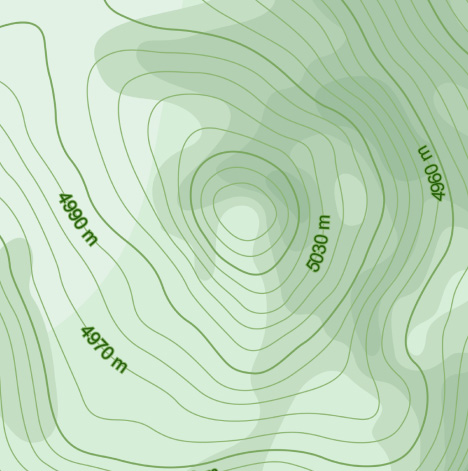The fastest route to success
How Mapbox bested giants and put itself on the map in navigation
When you compete with a company like Google, you have to run faster than them and stay incredibly focused.
David vs. Goliath
Combatting oversized incumbents is practically part of the job description for anyone working at a tech startup. PayPal sparred with financial giants; Airbnb, the hotel industry; Uber, taxis and their lobbies; Netflix took on Blockbuster first and Hollywood studios next. But going head-to-head with a company like Google—one of the most valuable companies on the planet, which controls vast swaths of the online world and has become synonymous with digital maps—can make the challenging startup journey even more fraught.“When you compete with a company like Google,” Sirota says, “you have to run faster than them and stay incredibly focused. And you should also be willing to innovate in ways that they’re not willing to innovate.” The story of Mapbox’s successful journey offers insights for any startup going up against a Google, Amazon, Microsoft, Meta, or other industry giant. Today, Mapbox’s technology is used by 40% of Fortune 500 companies. More than 4 million registered developers are building using Mapbox APIs and SDKs, and its technologies touch 700 million monthly active users and power more than 45,000 mobile apps. The company is becoming a powerhouse in the world of navigation, autonomous vehicles, logistics, and even AI.For some at the company, those successes, in the face of competition from such a richly resourced and powerful incumbent, are part of the thrill of working at Mapbox. “Almost every startup is really a David-versus-Goliath story,” says Garrett Miller, Mapbox Global Vice President of Customer Engagement, who joined the company in 2021. “Doing something new and bold and exciting while competing with Google was part of the attraction of the job.”
Mapping a path
Necessity, it is said, is the mother of invention. That certainly was the case with Mapbox. The company’s co-founder and former CEO, Eric Gundersen, never set out to build a mapping company that would compete with Google. With a background in economics and international development, Gundersen ran a small Washington, D.C.–based consulting business serving customers in government and humanitarian organizations. While creating data visualization maps for the likes of the World Bank and the U.S. State Department, they quickly realized that existing mapping tools and data weren’t up to the task.“Google Maps had North America and Europe but the rest was just ocean,” says Will White, a member of the Mapbox founding team. Moreover, its maps were meant to help people get from point A to point B, not dynamically display data on a map or support data analysis tools. “We figured if we were finding these huge gaps in what was out there, others would have that same need,” White says. They set to work to fill those gaps, and Mapbox was born in 2010.








Google loomed large over the company from the start. The founding team aimed to build something far more robust and flexible than Google Maps. But prospective investors saw the digital mapping market as settled and refused to back the company. As a result, Mapbox bootstrapped itself in the early years.Unlike Google, the company did not have the money to hire fleets of survey vehicles equipped with expensive sensors and cameras, so it adopted a scrappier, catch-as-catch-can approach. It built maps as it needed them for clients of the consultancy business, relying on open source repositories of geolocation data such as OpenStreetMap and Wikidata, supplemented by sensor data, satellite imagery, and eventually machine learning, as well as input from users. By 2013, Mapbox had built a product that allowed it to finally raise a $10 million Series A.
If you're going to go up against the behemoth, making sure that you have a counter business model is pretty important.
That was just the beginning, says Vikas J. Parekh, a managing partner at SoftBank Investment Advisers and a Mapbox board member, who calls OpenStreetMap the “canvas on which Mapbox was built.”Making a reference to the Jorge Luis Borges short story, “On Exactitude in Science”, an allegory about the impossibility of making a perfectly accurate map, Parekh says: “A map is a static picture of a dynamic world, so it needs to be updated constantly.” Part of the Mapbox executive team’s “ingenuity,” he adds, was figuring out early on how to make updates using information gathered by its customers’ digital devices. “They’re using those breadcrumbs and applying logic to develop a more and more dynamic view of the world. And they’re doing so for a fraction of what Google spends on its maps.”The first rule of battle is to claim your territory. Mapbox chose not to compete with Google Maps in the consumer space; instead, the company would be the innovator who drove the digital mapping industry forward for developers. “Our strategy from the very beginning has been to focus on developers,” says Sirota, who joined the company in 2018. Parekh says that strategic decision was prescient. “If you have a strong enemy, you don’t want to spread yourself too thin, or you’re going to get crushed,” he says. “You find a wedge and focus and apply maximum pressure. This is a team that knows its opponent well.”The more ambitious a customer’s vision and the more complex its use case, the happier Mapbox was, as it would allow it to open the world’s eyes to the vast potential of digital maps and geo-location. “You can always add more and more resolution and more and more information into the map,” says Alex Barth, VP of Automotive and another member of the Mapbox founding team. CNN, for instance, poured reams of election data into its maps, allowing news anchors to zoom in and zoom out on election nights to show granular voting data.Another early customer, Instacart, “really grew with us,” White says. Initially, that meant maps showing customers a delivery person’s progress. With time, it also meant intelligent route optimization through Mapbox Directions API and technologies that help Instacart plan and group deliveries.
Miller says being small and nimble can be an advantage. “We’re very much customer-oriented and customer-centric whereas some of these bigger companies have more of a take-it-or-leave-it attitude,” he says, adding that large companies with millions of customers, like Google, may not be as responsive to customer needs.While Google’s maps were mainly targeted at consumers, it, too, was pitching its product to developers, through a set of free APIs. That quickly established Google as the default for web and mobile maps. Initially, Google treated Maps much as it did search or Gmail: another way of engaging users, gathering data, and driving greater ad revenue. In June 2018, White says Mapbox got an unexpected bit of good news: Google announced it would start charging developers for using its APIs. “We no longer had to compete with free,” White says.Google has always had the engineering talent, along with near-bottomless stashes of cash that have allowed it to continuously improve its maps. To avoid getting caught in an arms race, Mapbox put the bulk of its focus on customization and flexibility. “We’re not a platform that is better than Google’s,” Sirota says. “We sell ourselves as a platform that enables developers to invent in the location space and build an excellent user experience. We are making an explicit choice to be incredibly customer-focused in everything we build and how we partner with our customers.”
The key to cars and logistics
The higher Mapbox moved up the stack in pursuit of larger customers, the more directly it placed itself in Google’s sights. That was never more true than in 2018, when the company’s top leadership decided to focus on large customers in the automotive and logistics industries. By 2020, in something of a coup and a testament to its engineering-first bona fides, it signed up BMW as a customer. Its advantage was offering a new model of software development for auto navigation that was highly customizable and allowed for regular updates. BMW proved to be what Barth calls a “lighthouse” customer that spotlighted Mapbox’s capabilities as car companies sought to find the right in-car navigation system. “Of course then we went to GM and Toyota and Rivian,” Barth says.Mapbox execs can list Google’s many advantages in the marketplace, including its reach, its mastery of search, and the vastness of the data it collects. But just like in other sectors, focus on customization, and the polish of the user experience it can offer customers, is the company’s calling card. “Getting a Google car implementation to look and feel like the brand of your company or individualized for a specific car is darn near impossible,” says Miller. Two carmakers can be fierce competitors, yet their navigation systems will be nearly identical if built with Google.“We empower automakers to create the experience they want any way they see fit,” Miller says. A customer can change the look of a map to better fit its brand or import its own data to point drivers to an EV charging network. “We have people calling on us who are Google customers today who are having problems trying to implement a feature, or influence a roadmap, or gain access to a particular set of data,” Miller continues. “Those are things a customer can make happen with Mapbox.”
Another big advantage Mapbox can exploit: as a car’s screen becomes increasingly important, many automakers are beginning to see Google as a potential rival. That proved a big advantage with GM. The Detroit giant, Miller says, “is looking at this big pane of glass in the center of the dashboard and going, ‘Do I want to cede that real estate to Google and let them control that or is that something I should control because it’s core and critical to the customer experience, my brand, and my ability to monetize down the road?’”That potential for monetization is only going to increase. Payments are beginning to move into the car, whether that means paying for parking, tolls, or the bill at a drive-through. Then there’s the intrinsic value of the data a car generates, which Google hopes to monetize. Mapbox, Miller notes, has no interest in that data, in part, because it has a fundamentally different business model. “If you're going to go up against the behemoth, making sure that you have a counter business model is pretty important,” Miller says.
How to compete with a giant. Five lessons from Mapbox’s success.
- 1
Pick your spots. You can’t do everything, so find a market niche where you can add real value. Mapbox chose not to go head-to-head with Google on a consumer map, instead zeroing in on developers who demanded customization and high-touch service.
- 2
Obsess over customer needs. Mapbox leaders and engineers engage in deep discussions with their customers’ execs and developers. Learnings are integrated into the company’s product through a methodical planning process. And highly complex mapping tech is delivered along with tutorials, demos, and resources that allow developers to move fast.
- 3
Run faster. Large companies are often slowed by layers of decision makers. Take advantage of your ability to make speedier decisions while staying focused on your vision.
- 4
Make bold bets. A copycat product won’t do. Given the clunkiness of voice assistants, Mapbox saw an opportunity to leverage generative AI to create a better experience for car drivers. MapGPT beat rivals to market with a more powerful solution that car makers are embracing.
- 5
Find a differentiated business model. For Google, car navigation software is partly about collecting data and selling ads. Mapbox sells technology to enable automakers to control the experience and build their own businesses around it.
That alternative message has also helped Mapbox gain traction in the logistics and delivery sectors, where Google, which has experimented with delivery services, is met with some trepidation. “A huge advantage for us in these massive markets is that we’re an alternative to Google,” Barth says. “There is no world in which the market would be satisfied with just Google.”That alternative message has also helped Mapbox gain traction in the logistics and delivery sectors, where Google, which has experimented with delivery services, is met with some trepidation. “A huge advantage for us in these massive markets is that we’re an alternative to Google,” Barth says. “There is no world in which the market would be satisfied with just Google.”
Chatbot co-pilots
Competing in digital maps and geo-location—or in any sector in tech—requires constant innovation and reinvention. In its early days, Mapbox focused on sharpening map accuracy, data visualization, and data analytics. Then it moved into search and navigation. Now, the focus has shifted to AI and the navigation requirements of vehicle autopilot systems and autonomous vehicles.Google, of course, has been a pioneer in both. It introduced the first self-driving cars, and spawned Waymo, arguably the most successful company in the sector; its engineers also developed many of the technical underpinnings of modern-day large language models and other technologies.Yet Mapbox still holds its own. It has teams working on AI-powered navigation and even beat Google to the punch by unveiling MapGPT in October 2023. The product enables carmakers to create customized voice assistants that can carry on natural and actionable conversations with drivers on the go. Looking for a restaurant a few exits ahead? Seeking to talk through a few ways of getting somewhere? MapGPT will allow users to engage in a give-and-take conversation with a voice assistant powered by a carmaker’s choice of LLMs.“What’s so exciting about this field is that location services are an integral part of so many industries and stacks of applications in all sorts of verticals,” Sirota says. With MapGPT, they’ll again be going head-to-head with Google along with other giants like Amazon, which of course has Alexa. But for Sirota, what else is new? “You innovate. You keep listening to the customer,” he says. “That is how you stay ahead.”






